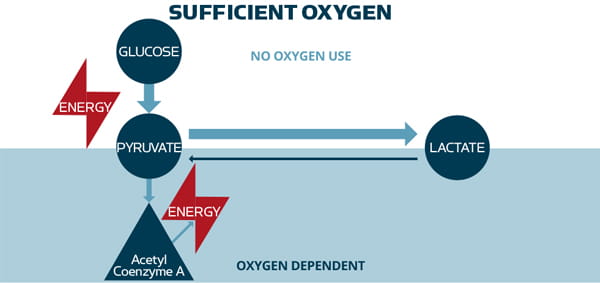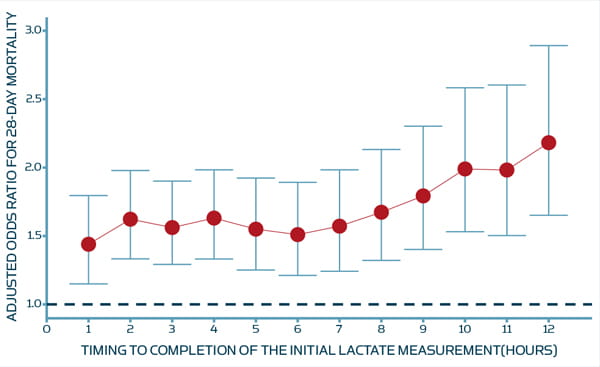Select your destination
Continue to Radiometer Medical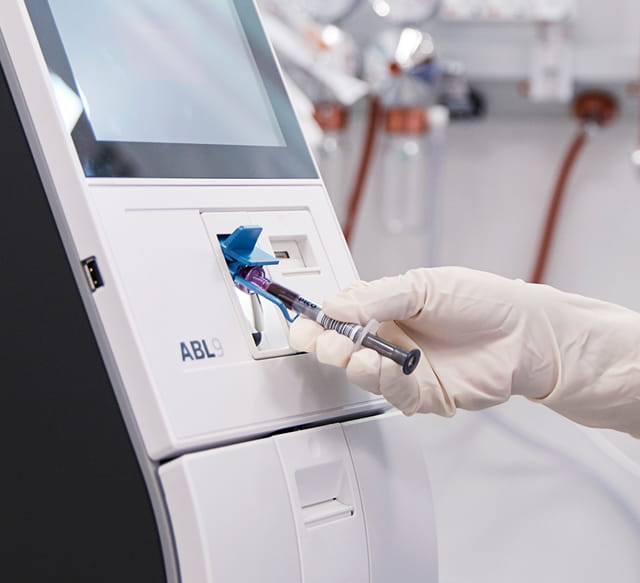
Lactate test
An important parameter at the point of care
-
 Produced at low levels in normal glucose metabolism [5]
Produced at low levels in normal glucose metabolism [5]
-
 A sign of biological stress when elevated [6]
A sign of biological stress when elevated [6]
-
 > 2 mmol/L may indicate critical illness [3]
> 2 mmol/L may indicate critical illness [3]
Lactate testing
Lactate measurements are widely used to monitor the effect of treatment in critically ill patients, as elevated lactate levels are associated with higher morbidity and mortality rates in this population [1,2].
Utilized early at the point of care (POC), lactate measurements can provide clinicians with important additional information to support critical treatment decisions [3,4].
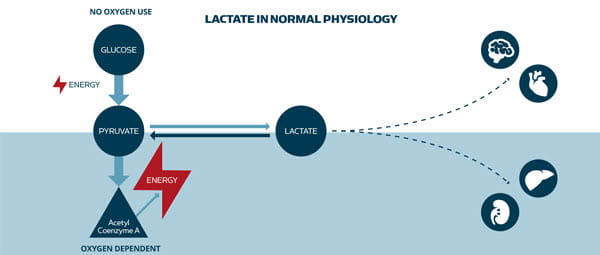

Role of lactate in normal physiology
The body’s cells produce energy by converting glucose into pyruvate, which is then converted into Acetyl Coenzyme A – the body’s main energy source [5]. The last part of the process is oxygen dependent. When oxygen levels are insufficient, pyruvate is metabolized into lactate [5].
Excess lactate is normally reverted to glucose by the liver (gluconeogenesis), or via oxidation as a direct energy source for cells [6].
This makes lactate an important fuel molecule, enabling energy shuttling between tissues, especially from the muscles to the heart and brain [7].
Lactate as a screening parameter
Blood lactate measurements are commonly used to guide treatment at the point of care [8].
The normal concentration of lactate is around 0.6–1.4 mmol/L [9] and levels increase upon biological stress. Hyperlactatemia is often an indicator of tissue hypoxia, as seen in patients with sepsis, but can also be present in patients with diabetes, liver disease, malignancies, intoxication, or inborn metabolic disorders [8,10].
In septic patients, a cut-off at 2 mmol/L can be used as indication of possible septic shock [11].
High lactate levels are also shown to be associated with worse outcomes in other patient groups admitted to emergency departments [8].
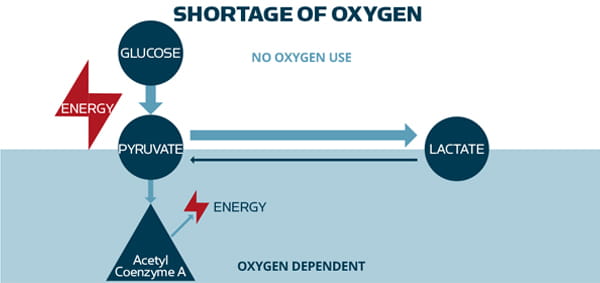

Supporting timely interventions at the POC
Sepsis is a leading cause of in-hospital death [4]. Measuring lactate aids in the management of sepsis and, because lactate levels correlate with disease severity, provides prognostic and monitoring value for patients with sepsis and septic shock [13].
The negative correlation between lactate level and prognosis is evident even at very high levels of lactate [14].
Early lactate measurement is associated with reduced mortality and better outcomes in septic patients, with a specific benefit seen when initial measurements are
made within one hour of ICU admission, and repeated within three hours [4].
Lactate POC testing has been shown to provide fast and accurate results within recommended timeframes [15,16].
Guidelines on lactate measurements
Guidelines from the Surviving Sepsis Campaign (Hour-1 Bundle) and UK Sepsis Trust recommend measuring lactate within one hour of recognizing sepsis or septic shock, and remeasuring if lactate is elevated (> 2 mmol/l) [17,18,19].
The UK Sepsis Trust also recommends lactate measurement in prehospital screening, if available [19].
References
1. Vincent et al. The value of blood lactate kinetics in critically ill patients: a systematic review. Crit Care. 2017;20: 257.
2. Mikkelsen ME, Miltiades AN, Gaieski DF et al. Serum lactate is associated with mortality in severe sepsis independent of organ failure and stock. Crit Care. Med 2009;37: 1670-77.
3. Freund Y et al. Serum lactate and procalcitonin measurements in emergency room for the diagnosis and risk-stratification of patients with suspected infection. Biomarkers. 2012;17: 590-5.
4. Chen et al. Early lactate measurement is associated with better outcomes in septic patients with an elevated serum lactate level. Crit Care. 2019;23: 351.
5. Rabinowitz JD, Enerbäck S. Lactate: the ugly duckling of energy metabolism. Nat Metab. 2020; 2:566–571.
6. Garcia-Alvarez M et al. Sepsis-associated hyperlactatemia. Crit Care. 2014;18: 503.
7. Ferguson et al. Lactate metabolism: historical context, prior misinterpretations, and current understanding. Eur J Appl Physiol. 2018;118: 691–728.
8. Nouland et al. Prognostic value of plasma lactate levels in a retrospective cohort presenting at a university hospital emergency department. 2017. BMJ Open;7:e011450.
9. Burtis CA et al. Tietz Textbook of Clinical Chemistry and Molecular Diagnostics. London: Elsevier Health Sciences. 2012.
10. Suetrong B, Walley KR. Lactic Acidosis in Sepsis: It's Not All Anaerobic: Implications for Diagnosis and Management. Chest. 2016;149(1):252-61.
11. Singer M et al. The Third International Consensus Definitions for Sepsis and Septic Shock (Sepsis-3). JAMA. 2016;315(8): 801–810.
12. Kreymann et al. Oxygen consumption and resting metabolic rate in sepsis, sepsis syndrome, and septic shock. Crit Care Med. 1993;21(7):1 012-9.
13. Dettmer MR et al. Sepsis-associated pulmonary complications in emergency department patients monitored with serial lactate: An observational cohort study. J Crit Care. 2015;30(6): 1163-1168.
14. Haas SA et al. Severe hyperlactatemia, lactate clearance and mortality in unselected critically ill patients. Int Care Med;42: 202–210.
15. Singer AJ et al. ED bedside point-of-care lactate in patients with suspected sepsis is associated with reduced time to iv fluids and mortality. Am J Emerg Med. 2014; 32, 9: 1120-1124.
16. Tolan NV et al. Analytical performance of three whole blood point-of-care lactate devices compared to plasma lactate comparison methods and a flow-injection mass spectrometry method. Clin Biochem. 2017 Mar;50(4-5):168-173
17. Rhodes, A., Evans, L.E., Alhazzani, W. et al. Surviving Sepsis Campaign: International Guidelines for Management of Sepsis and Septic Shock: 2016. Int Care Med. 2017;43: 304–377.
18. Surviving Sepsis Campaign. Hour-1 Bundle: Initial resuscitation for sepsis and septic shock. Society of Critical Care Medicine and the European Society of Intensive Care Medicine. (2019).
19. Daniels R et al. The sepsis manual. The UK Sepsis Trust. 2019.
Cookies are used on this website
Use of cookiesPlease enter a valid email
We will be sending an e-mail invitation to you shortly to sign in using Microsoft Azure AD.
It seems that your e-mail is not registered with us
Please click "Get started" in the e-mail to complete the registration process
Radiometer is using Microsoft AZURE Active Directory to authenticate users
Radiometer uses Azure AD to provide our customers and partners secure access to documents, resources, and other services on our customer portal.
If your organization is already using Azure AD you can use the same credentials to access Radiometer's customer portal.
Key benefits
- Allow the use of existing Active Directory credentials
- Single-sign on experience
- Use same credentials to access future services
Request access
You will receive an invitation to access our services via e-mail when your request has been approved.
When you accept the invitation, and your organization is already using AZURE AD, you can use the same credentials to access Radiometer's customer portal. Otherwise, a one-time password will be sent via e-mail to sign in.


